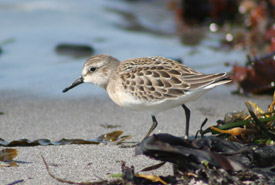Everything you need to know for safe and positive shorebird viewing

Semipalmated sandpiper (Photo by NCC)
Every summer, the Bay of Fundy is host to thousands of shorebirds as they migrate from their breeding grounds in the Canadian Arctic to their winter home in South America. Shorebirds stop at the Bay of Fundy to gain plenty of weight for the long migration ahead. To do this, they spread out over the exposed mudflats at low tide in search of invertebrates, like mudshrimp, and wait out the high tide resting on the beach.
Johnson’s Mills Shorebird Reserve is one of these important sites that provides a refuge for migrating birds, as well as many other species. The most common species to pass through the reserve is semipalmated sandpiper, but visitors may also see semipalmated plover, least sandpiper, sanderling and ruddy turnstone.
Best time to see shorebirds at Johnson's Mills
The best time to see shorebirds at the reserve is during the high tide period, two hours before and after high tide, as that’s when they should typically be trying to rest on the beach. Please do not try to get too close to the shorebirds during the high tide period — it is critical that they be able to rest undisturbed. The tide schedule is available at the information kiosk of the Interpretive Centre, near the parking lot.
During low tide, they will be out dining on the mudflats and are less likely to be disturbed. NCC interpreters are on-site to gather data, monitor the area and prevent visitors from disturbing the shorebirds. Here are some guidelines you can follow to make your visit more comfortable for the birds.
These apply not only to Johnson’s Mills, but any important shorebird habitat. Keep in mind, other areas may have different or additional guidelines. Always keep an eye out for posted signs when visiting a conserved coastal area.
Keep your distance
When you visit Johnson’s Mills, remember to social distance not only from other guests, but from shorebirds as well. Keeping your distance and staying off the beach is the best way to ensure your trip is safe and calm for the birds. If you get too close, the birds may fly away, call out or hunch down in preparation to fly. If you see this behaviour, move farther away.
Don't bring pets
Don’t bring pets to the area. Even well-behaved pets can disturb birds. Animals like cats and dogs are natural predators, which can make small shorebirds nervous. It’s best to leave your furry friends at home for this trip.
Walk softly
Walk softly when you visit the reserve. During low tide, avoid walking on the mudflats. You might disrupt the small invertebrates that the birds need to eat.
Keep noise and activity levels low
When arriving at a nature reserve, drive slowly, and don’t wave, shout or make other sudden noises that could be startling. Never intentionally try to make shorebirds fly. Not only is it against the law, but the birds need to reserve their energy for the long migration ahead.
Don't litter
Make sure you take any items or garbage that you brought with you. Birds may get stuck or tangled in pieces of litter or try to eat them. Bring a bag or other container to put garbage in and take it with you when you leave.
By following these simple steps, you will be able to view the magnificent shorebird migration safely and respectfully.





